 France (1870-1912) – About 60 cruisers
France (1870-1912) – About 60 cruisersWW1 French Cruisers
Sfax | Tage | Amiral Cecille | D'Iberville class | Dunois class | Foudre | Davout | Suchet | Forbin class | Troude class | Alger class | Friant class | Linois class | Descartes class | D'Assas class | D’Entrecasteaux | Protet class | Guichen | Chateaurenault | Chateaurenault | D'Estrées class | Jurien de la Graviere | Lamotte-Picquet classDupuy de Lome | Amiral Charner class | Pothuau | Jeanne d'Arc | Gueydon class | Dupleix class | Gloire class | Gambetta class | Jules Michelet | Ernest Renan | Edgar Quinet class
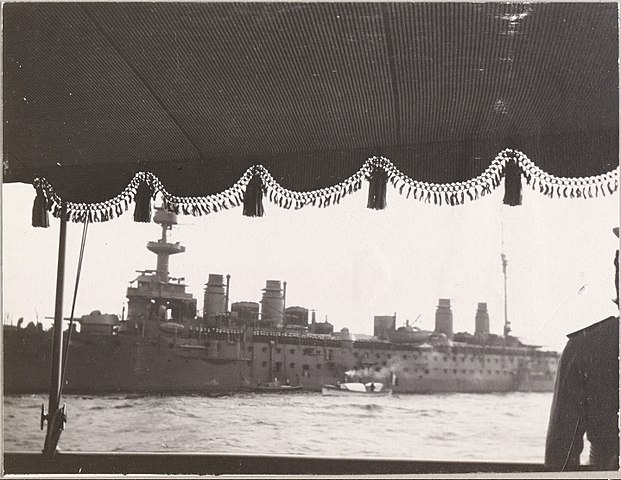
The armoured cruiser Condé, from the Gloire class, seen from the Romanov Shtandard Imperial Yacht, from the Romanov family album 2, page 26 (CC)
Compared to the relative simplicity of the interwar French lineage, the history of French cruisers goes back to 1860s steam frigates. The first “cruiser” per se (unprotected) was the Decrès launched in 1866. The forst protected cruiser was Sfax, in 1884, and the first armoured cruiser Dupuy de Lôme in 1890, which was arguably also the prototype for modern armoured cruisers, an influential design. Conway’s also included in the armoured “cruiser” section ships that were arguably more second-class ironclads, such as the Belliqueuse (1865), Alma class (1867), La Galisonnière class (1872), and barbette ships such as the Bayard (1880) and Vauban class (1883). Despite their peculiar nature, Torpedo cruisers (1885-1897) are also integrated here.
Specifics of French cruisers
Wjat can be said about French cruisers, compared to their foreign counterparts ? The early cruiser development did not differed much from other nations, the first cruisers were the continuation of mixed steam frigates, with better guns mounted on rails for greater arcs of fire. Wood was still widely used as France had a hard time to catch the British industrial capacity in terms of steel production in the 1870s.
Arguably the invention of the protected cruiser was British, with the experimental 1878 Comus class corvettes, which had a full-lenght protective deck, or the Italia class battleships (1880), which protection was limited to the protective deck again. Esmeralda (1884) was an export Chilean cruiser from Armstrong Elswick, later IJN Izumi, is generally credited as the word’s first true protected cruiser. The French Sfax was launched the same year, and all-metal, like following cruisers.
Tumblehome and plough bows: It is also typical of French cruisers of that era to have very pronounced ram bows, “plough bows”. More than 120 years before it was discovered the bulbous bow shape allowed hydrodynamic performances, the ram bow was take very seriously by the French admiralty, following the battle of Lissa in 1866. The plough bow as made by the French may look impressive but the shape was tailored to absorb the shock of the impact when ramming, and was compartmented so to not provoke damage or water leaks into the regular bow behind. The drawback though, was a tendency in heavy weather for the ship to “plough” in waves, which was dangerously wet.
The French “trademark” tumblehome also very popular on battleships and was another architectural fantasy of French designers under the Young school theories. The whole idea was basically about stability. It was though that this pear shape allowed to reduce the weight of the upper deck, making the vessel more seaworthy and allowing to make it a bit taller as well, with a greater freeboard. The French made it to the extreme the heavier was the ship, until dropping it completely after 1912 reforms. By then flat-side hulls became the norm. French cruisers used it, but until the end of the 1890s. By the start of the century this practice decreased. The last armoured cruisers for example had a moderate lateral slope and conventional straight stem.
The Young School and cruisers:
The whole raison d’être for the Jeune école (‘Young school’) was to compensate the disadvantage of the French Navy in battleships, using new tactics and innovation in naval warfare (ie, torpedoes, mines). This was basically to apply principles of asymmetric warfare to a whole navy, which was at the time in the 1880s, the world’s second. Cruisers for the school was just an afterthought, as the ship kept its role as in traditional navies, inherited from frigates.
However, the French came with a dedicated purpose for a new kind of cruiser: Used planning to raid trading assets of the enemy and curtail its economy. This was very much targeted against Great Britain, still a likely opponent despite an opportunistic alliance in the Crimean adventure of 1852. Both navies were looking at each others, when the Napoleon made its debut during this war, a steam conversion was immediately quick-started in both navies. In 1859 when the French unveiled the first sea going ironclad, the Royal Navy had to swap on the first all-metal ironclad and whole series followed. For cruisers, the British took the advantage with the protected cruiser, but France launched her first the same year (1878).
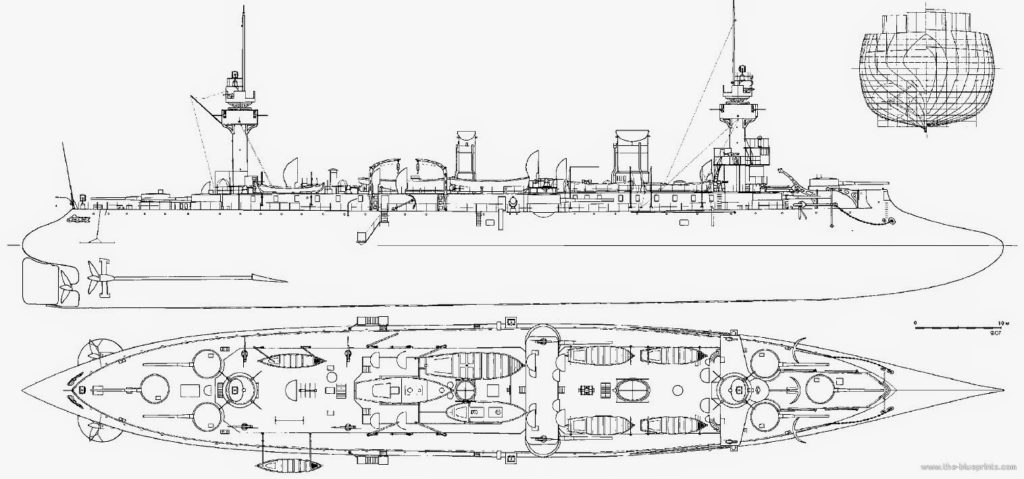
The cruiser Dupuy de Lôme (blueprints)
However for a raiding ship, it was important to defeat any cruiser that could be guarding and patrolling trading lanes. The Dupuy de Lôme was designed for this role, precisely, named after the great innovator of the French Navy. Dupuy de Lôme was laid down during 1888, capable of 23 knots and was a “long range killer”, able to defeat any cruiser afloat. The idea of an armoured cruiser was not new, the first were masted ships in the 1870s such as the HMS Shannon and the Russian General-Admiral.
Compared to “protected cruisers” which were a lighter version of the first, lacking a level of protection, armoured cruisers were designed with a full “armoured box”, protecting both the main artillery deck and the machinery spaces, often with sloped sides, belts, and ending with bulkheads to constitute an enclosed “box” called the citadel. This was common to these cruisers and battleships, but the latter had a thicker armour in connexion to the larger artillery caliber. The Dupuy de Lôme particular innovation was to be entirely steel-sheated and having military masts instead of being rigged.
The Jeune Ecole school of thought at large proposed a navy composed mainly of fast cruisers for commerce raiding, with torpedo-boats for coast defense. The result was very much the French Navy of the 1890s. However, the Dupuy de Lôme accumulated engine problems, completion was delayed until 1895, and not only she was not very seaworthy (notably because an exagerated plough bow), her armor could be penetrated with relative ease by modern quick-firing guns. Therefore after her and the Admiral Charner class there was until 1897 a “vacancy” in construction to study other designs.
The idea of a commerce raider was no lost to Jackie Fisher, well aware of the Jeune école concepts, and which own twists on these concepts were instrumental in designing the first battlecruiser. The Germans as well were very receptive to this tactical approach to the use of cruisers, and they used theirs (Von Spee’s squadron in particular) just for that purpose (see for example the Emden).
Arguably, the WW2 Kriegsmarine also applied these “asymetric warfare” concepts when using her capital ships, the three Deutschland class, the Scharnhorst class, and even the Bismarck and Tirpitz. Too few or ill-adapted for a battleline, they were thought for commerce raiding first, as Plan Z never materialized.
Armament:
Armament-wise, the French went with specific gunnery: Main gun on cruisers in the 1880-90s revolved around the 6.4 in (162 mm), and secondary guns 5.5 in (140 mm). Quite close, they could create a problem when spotting water plumes. Lighter armaments revolved around the 9-pdr (65 mm), 3-pdr (47 mm), 2-pdr (37 mm) Hotchkiss, standard or revolver models. Cruisers were also fitted with torpedo tubes early on, relatively small ones at 305 mm (12 inches), and in the 1890s, 18 inches or 450 mm became more common. As in other navies, these torpedo tubes were gradually removed, as not practical and potential sources of water spills. Many cruisers of this era could also potentially carry 120 mines.
Some ships in the French Navy were very lightly armed, such as the very last unprotected cruiser, the Milan (1884), was a 1,700 tonnes ship very lighlty armed, with two 4 inch guns, and 13 small/light guns. Too slow for reconnaissance at 18 knots, the concept was not very useful. She was also the onl non-sailing French cruiser, but soon protected cruisers became the norm. Early masted protected cruisers such as the Sfax, Tage, and Admiral Cecille were given the armament above, declined on all protected cruisers until the Jurien de la Gravière (1899). The latter was given the Modèle 1893 164.7 mm (6.48 in)/45 guns, completed by the Modèle 1885 47 mm (1.9 in)/40 guns and Modèle 1884 37 mm (1.5 in)/23 guns found on earlier ships.
Modèle 1887 194 mm (7.6 in)
The late 1890s, early 1900s saw on armoured cruisers a new standard: The 7.6 in gun (194 mm) was 8.7302 meters long and weighted 10.770 tons total. The bore caliber was 194 mm, rifled, and the barrel caliber reached 630 mm. Muzzle ddevlocity was about 770 to 800 meters per second depending on the projectile, which stayed at 600 to 619 meters per second in flight after travelling some 2 000 meters.
The later 1893 model is a shortened version, heavier at 10,840 tons, 8,076 m long or 40 calibres instead of 45. Internal volume rose from 43,389 to 49,030 dm31. The M1887 went to the first battleships built for the French Navy, the cruiser the Dupuy-de-Lôme and five units of the Amiral Charner class. The Pothuau was given the 1893 model, in the same layout.
Modèle 1893 164.7 mm gun (6.48 in)
This gun weighted 7.04 t (6.93 long tons; 7.76 short tons), for a barrel length of 7.412 m (24.32 ft), a separate-loading, bagged charge, and fired a 50.5–52 kg (111–115 lb) shell. It used a Welin breech block, with Hydro-pneumatic recoil also found on the famous “75 mm Modèle 1897”. The gun average alevation was about -10° to +25°, for a rate of fire of about 2-3 rpm (whereas the ’75’ could fire 15-30 a rpm burst (dependent on crew training and fatigue). The 164 mm muzzle velocity was 770–775 m/s (2,530–2,540 ft/s) and effective firing range was 9,000 m (9,800 yd) at 25°. Its maximum firing range was 18,000 m (20,000 yd) at 36°. It was mounted on the last French armoured cruisers (Dupleix, Gloire, Gueydon, Léon Gambetta) and République-class pre-dreadnoughts. The M1893 was soon eclipsed by the 194 mm/40 (7.64″) Modèle 1893 and the 194 mm/50 (7.64″) Modèle 1902. Postwar, France adopted the more conventional 8-in heavy caliber (203 mm), but 6.1-in for light cruisers (155 mm).
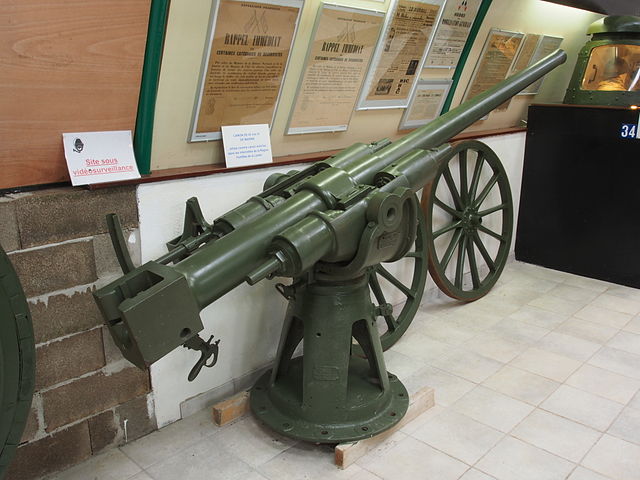
Modèle 1891 65 mm gun (2.6 in)
For tertiary guns, the Canon de 65 mm Modèle 1891 became widespread (2.6 in). It was designed by Schneider et Cie and produced by Le Creusot. It was 3.4 meters (11 ft 2 in) long, with a barrel length of 3.2 meters (10 ft 6 in), 50 caliber, and fired a Fixed QF shell weighting 4 kilograms (8 lb 13 oz). It used a Wedge breech system, and muzzle velocity was about 715 m/s (2,350 ft/s).
Hotchkiss 47 mm L/40 M1885
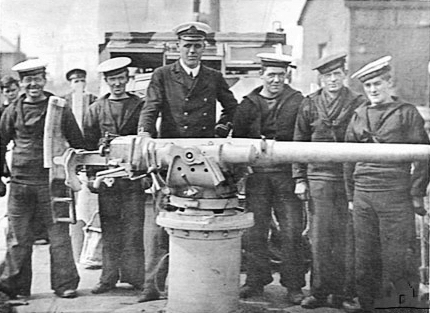
This QF gun was an international success story, by an American which created his company in France and was made famous for his guns and machine guns, competitors of Vickers own products. The Hotchkiss L/40 M1885 was also known in the Royal Navy the QF 3-pounder (or 1.9 in) and was fairly common. It used a vertical sliding-wedge, and its rate of fire was about 30 rpm, for a muzzle velocity of 571 m/s (1,870 ft/s) and a maximum firing range of 5.9 km (3.7 mi) at +20° and 4.5 km (2.8 mi) at +8. The gun was also licenced built by Obukhov in Russia, Skoda for the Austro-Hungarian navy and Elswick Ordnance Company for export, reaching many navies, including the IJN (Imperial Japanese Navy).
Homogeneous classes
Unlike battleships classes where lots of experimentations took place, French cruisers were generally a bit more homogeneous in constructions, with slightly more classes than for battleships, but still many single ships. For unprotected cruisers, for example, there were seven classes (32 ships) for 16 single ships. For protected cruisers, nine classes (24 ships) for 9 single cruisers. For armoured cruisers, six classes (20 ships), for only 5 single ships. As a reminder, for battleships (before the dreadnought age and 1912 De Lapeyrère reforms), not starting with central battery ships (1868-82) or barbette ships (1879-83), but with the Hoche, there were two classes (6 ships) for 10 single ships.
For practical reasons, some of these were integrated artificially in the Charles Martel class. Another specifics of French cruisers classes were they went by three more often, if not as a standard. The idea was to have one ship reserved for the Atlantic fleet, one for the Mediterranean fleet and one overseas along the French Empire, with potentially one of the three in drydock maintenance.
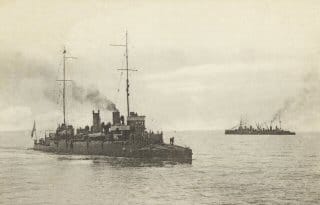
The torpedo gunboat Dunois and the cruiser Gloire in the background. From Pinterest, origin Unknow.
Torpedo Cruisers were popular, before “destroyers” (by then called contre-torpilleurs) were invented, because perfectly in line with the theories of the obnoxious (in retrospect) Young School. The type, just like coastal “battleships” was particularly popular in the young school. Torpedo cruisers were the smallest of the lot, precursors of torpedo boat destroyers. They were lightly armed and had the double task of leading TBs, while protecting them and destroying other enemy TBs.
However the denomination changed overtime, recognising the too great disparity in tonnage with regular cruisers and swift in role: The first Condor and Wattignies classes were “cruisers” wheras the Bombe, Lévrier, D’Iberville, the Dunois class were “gunboats”. The French still classed the latter as “contre-torpilleurs” but they were much too slow to be effective in that role and never really found their place in the French Navy, as in many others. In Total, the French would deliver 21 of these torpedo ships, versus 33 “torpedo gunboats” for the Royal Navy.
Italy, Austria-Hungary also toyed with the idea, but not Germany, Japan or the USA. However, France, like Great Britain tried the torpedo mothership concept: HMS Vulcan inspired the Foudre. Both were unsuccessful and converted later as a depot ship or seaplane carrier (Foudre) respectively.
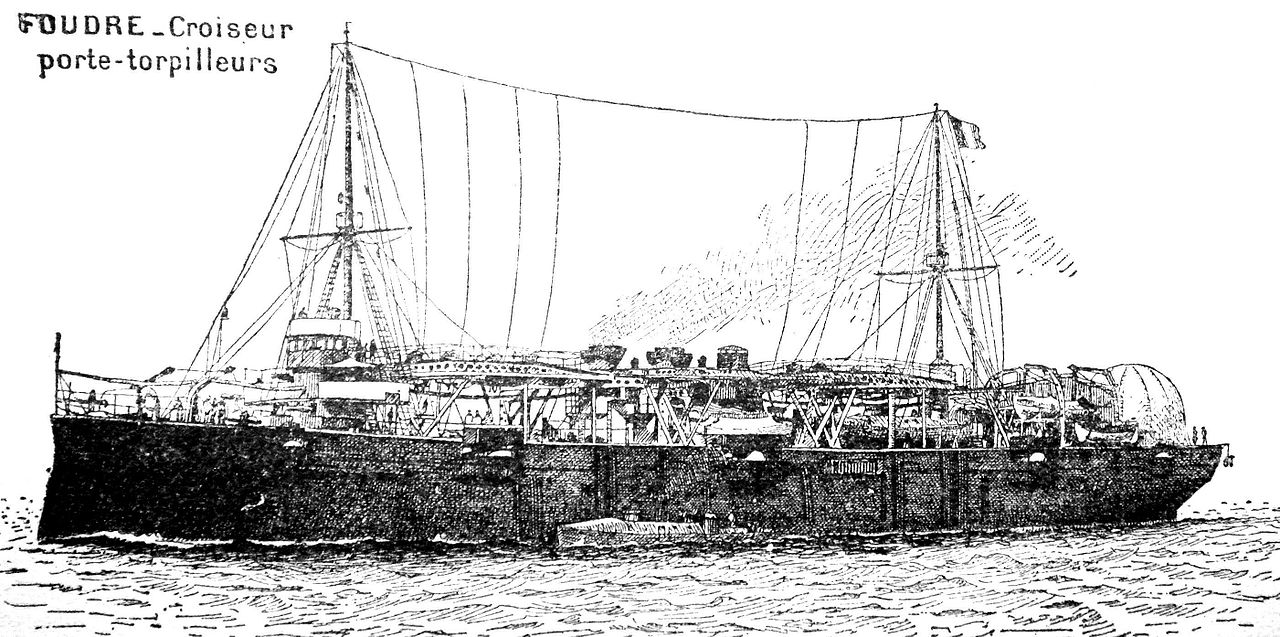
The 1894 Foudre was another take on the “torpedo boat mothership” which proved a failure. The French recognised the previous HMS Vulcan’s failure as the inability of its midget TBs to deal with the heavy weather of the north sea, and thought the Mediterranean better suited for the concept, but their experiment fell under the same predicament.
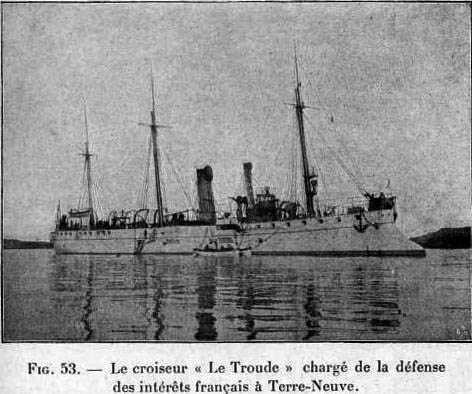
The Troude – University Library of Congress, Washington (cc)
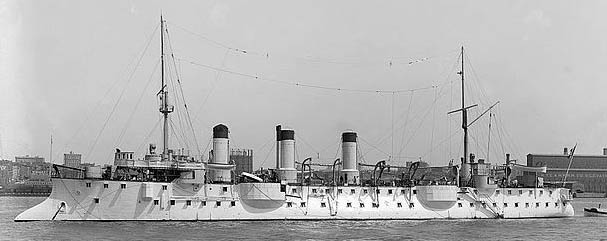
Protected cruiser Chasseloup Laubat LOC 4a15950v (CC)
Former Frigate-size mixed vessels (1860-1876)
Circé type converted Frigates
This comprised 11 converted sailing frigate group laid down in 1829-1850 from various yards. Displacement range considerably between 2,740 tonnes (Armorique) and 3,935 tonnes (Magicienne). Armament ranged from 42 to 56 guns, but after modifications, 24 to 36 mostly 6.4 in M1860 and 5.5 in RML. Completed in 1862 to 1870 they were discarded in 1875 to 1888.
Wooden-hulled steam corvettes & frigates (1862-77)
Next were built eight steamships, the wooden screw corvettes 1,795 tons Cosmao and Dupleix, the 1,387 tons Talisman, 1,795 tons Résolue, the 2745 tons wooden screw frigates Vénus and Minerve and the first wooden hull cruisers, the 1,870 tons Decrès and the 1,722 tons Desaix. Also the 1323 tons Limier class (6 ships, 1867), the 1820 tons Châteaurenault (1868), 1191 tons Linois (1867).
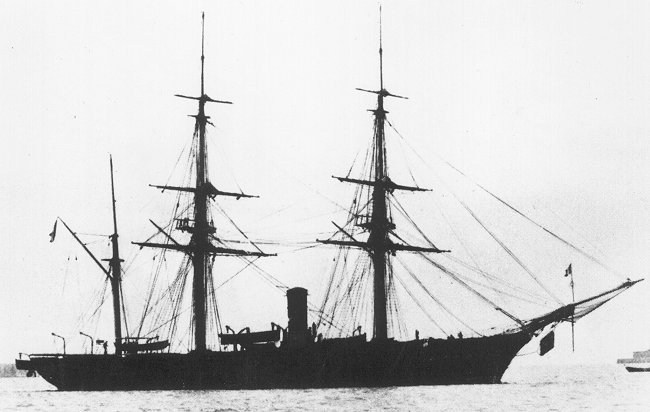
The Frigate Dupleix in China
Built in parallel along an ambitious naval plan, the Infernet class (4 2042 tons ships, 1869-74), Sané class (three 2072 tons vessels, 1869-74), Bourayne class (10 vessels, 1330 tons tons, 1869-72), the ex-Imperial Yacht Hirondelle (1181 tons, 1869, converted 1873), and the more modern Rigault de Genouilly class (2 ships launched 1876) inaugurated a plough-style ram bow. They were all discarded in the 1890s but participated for many to the Sino-French war.
Iron masted cruisers (1877-84)
This new lineage started with an ambitious long-range 3479 tonnes all-iron vessel, the Duguay-Trouin (1877). Sheated and coppered she used the same plough ram bow and had an overhanging stern, and was barque rigged. She was armed with five 7.6 in RML (180 mm), four in sponsons, one axial, five 5.5 in, ten 1-pdr Revolver and for the first time, two underwater torpedo tubes. The Duquesne (1873) was relatively similar but larger, at 5905 tonnes and the Tourville was a near-sister ship.
There was a return to smaller station masted cruisers with the Lapérouse class (4 ships, 2363 tons, 1877-82), and Villars class (4 ships, 2382 tons, 1879-82) and the 3300-3700 tonnes Iphigénie (1881), Naïade (1881), Aréthuse (1882), and Dubourdieu (1884). All but the Aréthuse has a clipper bow; The last unprotected French cruiser was the Milan, a 1,700 tons narrow cruiser and forerunner of the protected Forbin and Troude classes (1884). She had a minimal sloop rigging. All these cruisers were discarded in the late 1890s to 1908 for the Milan.
French Masted protected cruisers
There were three “transitional” cruisers built at the same time the protected cruiser concept appeared, and the Milan, last unprotected cruiser. The first two were discarded in 1906 and 1910 but the third in 1919. All three will be covered in detail when examining the French Navy in 1895.
Sfax (1884)
A two-funnels, ram bow, overhanging stern barque rigged 4560 tonnes cruiser armed with six 6.4 in guns in sponsons and casemates, ten 5.5 in guns in broadside ports, and ten revolver guns plus five torpedo tubes above the waterline. They were designed as long range ships for distant stations. They were made with a protective deck 2-3 feets below the waterline, 2.4 in thick in four layers. There was also a 1-in thick conning tower in between the two funnels where the bridge was located. The formula was never repeated; The hull had a cofferdam and cellular layer between the armoured deck and upper decks to limit water damage.
Tage (1886)
A much larger (7470 tons) three-funneled protected cruiser with a plough ram bow and tumblehome, barque rigged. She received two more main guns and was later reamed with 162 mm guns and 140 mm QFC guns. It was generously provided with revolver guns, of 3-pdr and 1-pdr. The protective deck was down to 2.2 in, with 2 in slopes, and there was a 3ft 3in cofferdam above it, 3.5 bulkheads, and a 3.5 in conning tower.
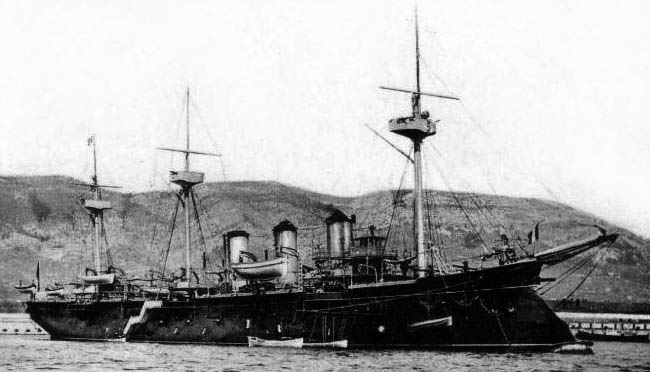
Amiral Cecille (1888)
A smaller but generally similar 5,836 tonnes vessel, barque without royals, armed the same as the Tage. Seven of her main guns were on the upper deck: Six in sponsons and one firing forward, the eight right aft on the poop. The 5.5 in were on the main deck broadside. The protective deck was 2.2 in total on the flat section, 4 in on the slopes, ending at 4.2 in below the waterline. Above there was a cofferdam with a seemingly better underwater compartmentation.
Bulkheads were 3.1 in (80 mm) and the CT was 3.5 in thick (90 mm). Contrary to the two others she had two shafts connected to four vertical compound steam engine fed by 12 cylinder boilers, rated for 10,200 ihp, enough for 19.4 knots. She carried 925 tonnes of coal. Contrary to the two others, Cécille, which entered service in September 1890, served in the French Caribbean, and from 1907 she was used as a school ship for mechanics in Toulon and was still active in 1919.
Barely cruisers: French Torpedo Vessels
Although most of these are “gunboats” they are integrated here for practical purposes. They are not integrated into the main count of “cruisers” and were only a ten-years fad, soon eclipsed by faster torpedo boat destroyers.
Condor class Torpedo Cruisers (1885)
These first torpedo cruisers were six one-funneld ships with plough bow, considerable tumbelhome, forecastle and poop, classed as crusiers whereas they were more torpedo gunboat, somewhat large at 1,230 tonnes. The Condor, Epervier, Faucon and Vautour (birds of prey) were laid down in 1884, launched 1885-89 and completed in 1886-89, at Rochefort and Toulon. They had two shafts IC or HC engines 4 cyl. boilers for 3000 ihp and 17 knots, armed with five 3.9 in, four 3-pdr, six 1-pdr and four 14 in TTs. All were discarded between 1907 and 1911.
The next Wattignies class (1893) were similar except for less width, more draught, and more displacement, 4000 ihp for 18.5 knots, Six 3-pdr instead of four and four 1-pdr. With Fleurus she was discarded in 1908-1910.
Bombe class Torpedo gunboats (1885)
Denomination changed for these eight much smaller, three-masted ships (369-430 tons FL), 59.20 m long which were given two shafts VC and loco boilers for 1,800 ihp, enough to reach 19 knots at best. They were armed with two 3-pdr, five 1-pdr, two 14-in TTs. These were all built at FC chanters de la Méditerranée except for Ste-Barbe and Salve, at Claparède, launched 1885-86 and completed in 1887-90 and discarded in 1906 to 1911.
Lévrier class Torpedo gunboats (1891)
Léger and Lévrier were 503 tonnes torpeod gunboats, two-masted, again with a pronounced tumblehome, but a straight stem, slight foredeck elevation, two shafts VTE for 2,400 ihp and 18.7 knots, armed with one 9-pdr, three 3-pdr, two 1-pdr and two 18-in TTs (457 mm) forward and aft of the funnel. Both were built at Lorient in 1890-91 and completed in 1891 but stricken in 1910 after 19 years of service.
D’Iberville class Torpedo gunboats (1893)

Author’s illustration of d’Iberville during the war.
Looking like midget cruisers, these three ships, Casabianca, Cassini and d’Iberville were in service by 1894-1896. They were much larger and almost twice as heavy than previous ships (Lévrier class) twith a forecastle fore and aft, and a larger and better distributed artillery. D’Iberville was the only one to actually have 6 TT versus 3 on the other two. In 1899, they were removed.
Casabianca and Cassini were rebuilt in 1911-12 as minelayers, and were replaced in that role by Pluton and Cerbere in 1913. They fought in WW1: Casabianca hit on a mine off Smyrna in June 1915 and sank, and Cassini was torpedoed by a U-boat in February 1917 in the Strait of Bonifacio. D’Iberville was in station at the port of Penang when the Russian cruiser Jemchug was crippled by SMS Emden. At first the captain believed it was an accident and let the German cruiser go without a fight. Back in the Mediterranean threater, D’Iberville patrolled off the Algerian coast until 1917 and was stricken in 1922.
Dunois class Torpedo gunboats (1897)
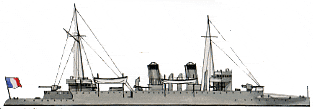
Author’s illustration of the Dunois during WW1
Dunois and Lahire, named after two famous knights alongside Joan of Arc, adopted an inverted deck design, low at the front back, rather than forecastles. Lighter, they were more powerful at 7500 vs 5000 ihp but did not reached more than 22 knots.
They were reclassified as destroyers despiteb their poor performances, and did possessed TTs. Dunois made ther service in UK, operatin off Dunkirk in support of British troops. She was stricken in 1920. Lahire was a training ship for Toulon’s gunners, and patrolled the Mediterranean. In 1918, a she received tow 100 mm guns model 1917, and six 47 mm guns, plus ASW grenades. She was stricken in 1922.
Foudre Torpedo depot ship (1895)

Author’s rendition of the Foudre in 1915 as a seaplane carrier;
The foudre was a singular vessel, but not a unique case (HMS Vulcan), called a “porte-torpilleur” or litt. a “torpedoboat carrier”. This was one of the innovative and cherished “young school” prototypes. By default of giving battleships small torpedo boats, a dedicated carrier was tested; Foudre was given two sections on which midget TBs (“torpilleurs vedettes”) were stored and lowered at sea by rolling gantry cranes. However soon, tests showed these midget TBs too small to be effective despite their 18-meters. They were just unstable in heavy weather and unoperable.
The concept was abandoned even though the ship was barely in service, after being completed in 1897. In 1900, the Foudre was ten in hands for conversion as a minelayer, and in 1912 as an experimental seaplane carrier. She was based in Port Said and Mudros and after 1917 served as a submarine depot ship, discarded in 1921.
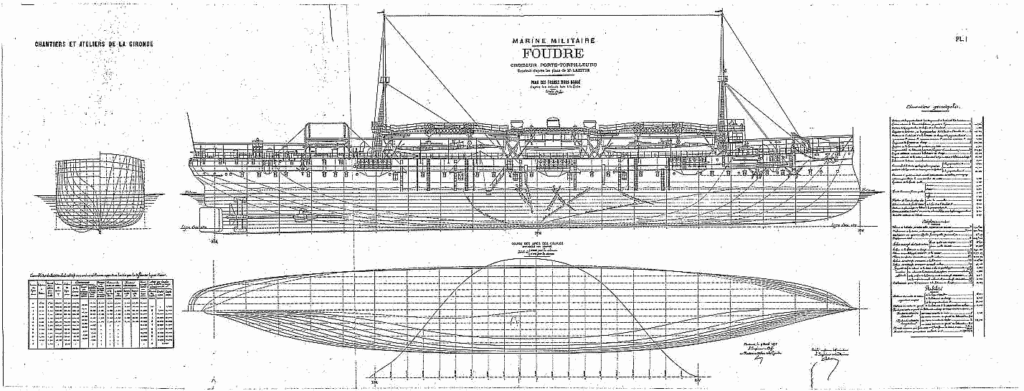
La Foudre, original blueprints, 1890.
1912 programme and the “never were cruisers”
The very last French cruiser prior to WW1 was the Waldeck-Rousseau (1908), second of the Edgar Quinet class. These were 13,847 to 13,995 long tons (14,069 to 14,220 t) comparable to the German Blücher and British Warrior class. These were massive ships designed to take part in the battle line, bearing a main battery of fourteen 194 mm (7.6 in) guns ready to cause havoc on enemy ships superstructures.
This was less than the heavier standard chosen by RN ships, comprising six heavier guns (254 mm) and four 190 mm, but the French had an advantage of rate of fire. The appearance of the dreadnought in 1906 pretty much made both pre-dreadnoughts and armoured cruisers obsolete overnight. Soon the French devised their first idea of a Battlecruiser, which will revolved through Gilles and Durant-Viel studies.
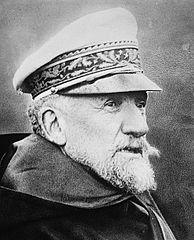 Besides this, Admiral Boué de Lapeyrière, in charge of the French ministry of the Navy, wrote and published the Statut Naval (Naval Law) on 30 March 1912, with an ambitious naval program, which not only stroke definitely earlier experiments of the “Young school” but managed to confirm the effort engaged since 1905 in built homogeneous class of ships (notably the République and Patrie battleships). The program, which advised the construction of 28 battleships, 10 scout cruisers and 52 fleet torpedo boats among others, clearly sent a signal to restart cruiser construction which had been virtually suspended after the last armoured cruiser.
Besides this, Admiral Boué de Lapeyrière, in charge of the French ministry of the Navy, wrote and published the Statut Naval (Naval Law) on 30 March 1912, with an ambitious naval program, which not only stroke definitely earlier experiments of the “Young school” but managed to confirm the effort engaged since 1905 in built homogeneous class of ships (notably the République and Patrie battleships). The program, which advised the construction of 28 battleships, 10 scout cruisers and 52 fleet torpedo boats among others, clearly sent a signal to restart cruiser construction which had been virtually suspended after the last armoured cruiser.
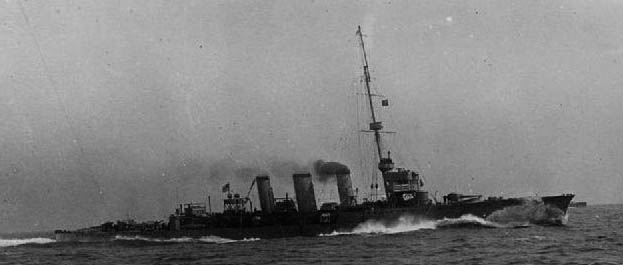
The 1912 Arethusa class was the main inspiration for the French first scout cruiser design
Models for these scout cruisers were not hard to find: Both the Royal Navy and Kaiserliches Marine, Regia Marina and KuK. Kriegsmarine all created their own version of the same concept. In fact, France would earn four of these as war reparations in 1920, Metz, Colmar, Strasbourg and Thionville. It was a far cry of the 12 ships initially planned. The French scout cruisers, cut short by the war, were to be named La Motte-Piquet, from a French admiral of the XVIIIth century.
At first, a 6,000-tonne éclaireurs d’escadre (fleet scouts) design was chosen, more versatile, but soon a lighter ship similar to the British Arethusa class was preferred. There was no precedent indeed. The last unprotected cruiser, Milan (1884) was barely capable to reach 18 knots, and the last protected cruiser, Jurien de la Gravière, was too large for the job. The initial sketches and specs also looked liked on the Karlsruhe class and Magdeburg classes.
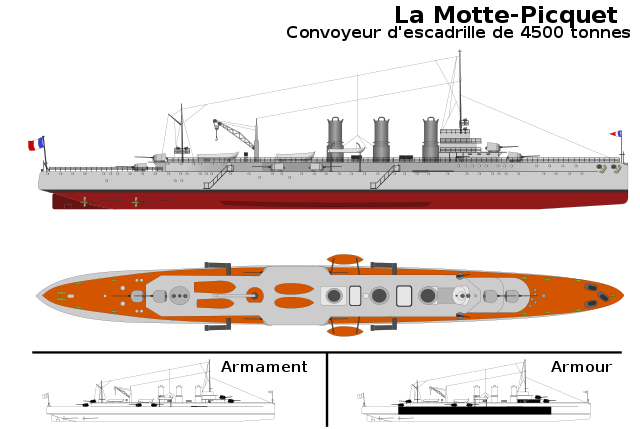
Attempt of a rendition of the Lamotte-Picquet (wikimedia CC)
The first three of these new cruisers, reclassified as “convoyeurs d’escadrilles” or flotilla leaders were planned to be laid down in Toulon Naval Dockyard by November 1914. Two more were planned for a construction in private shipyards to spare construction time. However after Germany declared war on France by August, 3, 1914, all naval construction in France were suspended.
The La Motte-Picquet program was left suspended to a further decision. They were reviewed again by a commission in July 1915 (Service technique des constructions navales). They made several suggestions to improve the design, as enlarging the hull and adding four 65 mm/50 Modèle 1902 high-angle (AA) guns, deleting the mainmast, reducing shafts to two. Not adopted, plans remained unaltered in a folder for the remainder of the war.
France had its light cruisers as war prizes, both former German and Austro-Hungarian vessels after the war. On September 1919, the program was relaunched, 1915 changes were applied, and the project evolved into the first postwar French cruiser design, the Duguay-Trouin-class.
The revised plans under ‘Project 171’ concerned six cruisers, presented by the new French Minister of Marine, Georges Leygues by January 1920. After a major restructuring plan it was cut down to three. Twelve new “torpilleurs-éclaireurs” (scout torpedo boats) were also scheduled.
The same plan also oversaw the conversion of the Normandie class into the aircraft carrier Béarn.
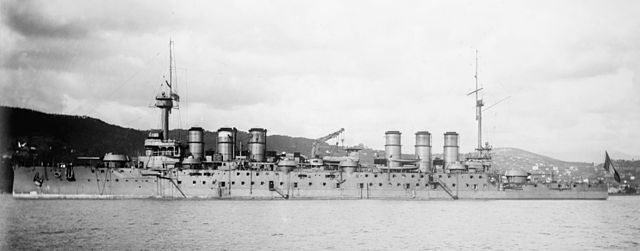
Ernest Renan, library of Congress (cc)
The La Motte-Picquet class were interesting prospective light cruisers designs, a first for the French Navy as the type was previously never built. They had an armoured belt on their outer hull, but only 28 mm (1.1 in) thick over the machinery ended by bulkheads of 14–16 mm (0.6–0.6 in). Gun shields were 5–10 mm (0.2–0.4 in) in thickness, barely protecting from shrapnells. The conning tower could have been armored at least by 30 mm but figures are not known.
The cruiser’s primary armament was eight 138.6 mm (5 in) guns Model 1910. They were the same used in the secondary battery of the new Courbet and Bretagne-class battleships. Main guns were placed in single mounts in a pair forward, two aft, and four amidships. Anti-TB armament comprised two 47 mm (2 in) QF and 3-pounder Hotchkiss guns (37 mm) of the same dependable model mounted on other ships. Torpedo armament comprised four 450 mm (18 in) torpedo tubes placed on the main deck, above the engine room, with reloads.
Instead of a raked bow, the designer choosed a simpler straight stem while the hull shapes were traditional. The propulsion system was little innovatove as well, and did not used turbines, but instead proven VTE engines, fed by twelve boilers. Also eight were coal-fired and four partial coal/oil-firing. Top speed as designed was not blistering even for 1913, targeted at 29 knots (54 km/h; 33 mph).
French protected Cruisers
Here are various “modern” ships, not rigged vessels in service at least for one ship in each class, during the Great War.
Davout (1889)
A smaller (3030 tonnes, 88 x 12 x 6.6 m) two-funneled steam cruiser, she had a pronounced plough style ram bow, and considerable tumblehome. Her military masts were of the same style of the battleships of the time. Armament comprised six masked 6.4 in (162 mm), four 9-pdr, four 3-pdr, 2-1pdr and six broadside TTs above the waterline. The 162 mm guns were placed in sponsons on the main deck and the remainder fore and aft on the forcastles. For the first time, ITE (Inversed triple expansion) steam engines were tried. With 9000 ihp from her 8 Niclausse boilers, the ship reached 20.7 knots and carried 840 tons of coal. Armour was about the same as on the Cecille but lighter: 2.8 in on the CT, 2-4 in on the armoured deck and slopes. She was stricken from service in 110.
Suchet (1893)
Generally similar to the Davout, almost a sister-ship, but with a longer hull at 97 m. She displaced 3362 tons. She had an Horizontal triple expansion engine which developed 9500 ihp thanks to 24 Belleville boilers, but she was slower at 20.4 knots. Armament was reinforced, with four 3.9 in guns (100 mm) instead of the 9-pdr, twice more 3-pdr (47 mm), eight 1-pdr (37 mm) Hotchkiss QF revolver guns, and seven TTs, one submerged and the other above the waterline. Like for the Davout they were gradually retired. The protective deck was 3.4 in thick. Suchet was discarded in 1906.
Forbin class (1888)
Small station cruisers with fine lines and plough bows. They had a length/width ratio of 1:10 (95 x 9 m), were propelled by two shafts HC engines, 6 boilers for 5800 hp, and with displacement of 1,935 tonnes standard, they reached 20.5 knots. They carried 300 tons of coal. Armament was light twoo, only four 5.5 in guns (130 mm), three 3-pdr, four 1-pdr revolver, four 14-in TTs and they could carry 150 mines. These two funneled ships also had two light masts able to carry sloop sails as auxiliaries, but not the Surcouf, apparently fitted with military masts. Their protective deck was limited to 1.6 in thickness with a splinter deck above the machinery space. Surcouf was fitted with a conning tower, and she was also the only one of the three ships, in service during WW1. Coëtlogon was stricken in 1906 and Forbin became a collier in 1913. Forbin’s engines were converted to mixed oil/coal boilers and eight 3-pdr guns were installed.
Troude class (1888)
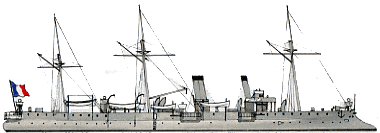
Generally similar cruisers to the Forbin class, but with three light masts and raked funnels. All three diverged in displacement: Troude 1,994 tonnes, Lalande 1,968 tonnes, Cosmao 1,923 tonnes. Armament was the same but with the two sponsons closer together. Only Troude and Lalande had an armoured CT, with 1-in plating. The four 305 mm TTs were removed in service and the 3-pdr were increased to 10 guns. The only survivor of the class, Cosmao, was built in Gironde arsenal in Bordeaux in 1887, launched in 1889 and completed in 1891. Of light construction, she did barely reached 20 knots, as vibrations hampered artillery precision and observation systems. Operating in the Mediterranean, Cosmao will soon be relegated to secondary duties, before being removed from the lists in 1922.
Alger class cruisers (1891)
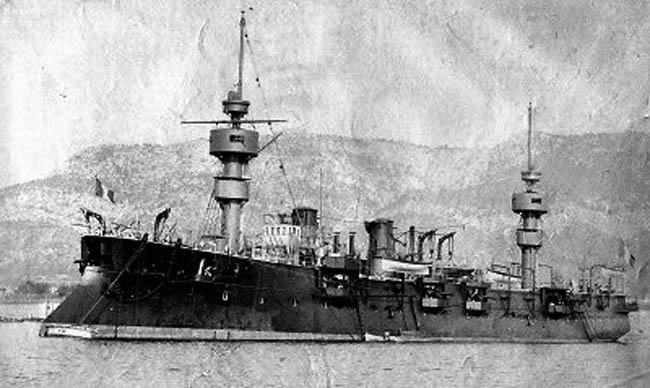
The cruiser Jean Bart (cc)
Relatively large two-funneled cruisers with military masts, plough bows and tumblehome. Alger had an overhanging stern, not the Isly and Jean Bart. Laid down in Cherbourg, Brest and Rochefort in 1887, launched in 1889 and 1891 and completed in 1891-93, they carried a heavier armament as before: Four 6.4 in/28 model 1887, six 5.5 in/30, two 9-pdr, eight to twelve 3-pdr, eight to ten 1-pdr guns and five 14-in TTs. The main guns were in sponsons, like the secondary ones to the exception of a single poop 5.5 in gun. They were capable of 19.5 knots, good steamers. Alger was hulked in 1911, Jean Bart was wrecked on 11.2.1907 on the north African coast. She has been reboilered with Niclausse models in 1903 in order to reach 20 knots. Isly survived until 1914 but was discarded.
Technical specifications
Displacement: 3,982 tons FL
dimensions: 105 x 12.98 x 6.10/6.45 m
Propulsion: 2 shafts VTE/HTE, 8 cyl. boilers (or 24 Belleville on Alger), 8,000 hp, 19.5 knots.
Crew: 387-405
Armour: CT 3 in, deck 2 in, gun shields 2 in
Armament: 4 x 162, 6 of 140, 2 x 65, 12 x 47, 10 x 37 mm, 5 x 305 mm TT bw
Friant class (1893)

The Friant class was originally a class of three, also comprising the Bugeaud, Chasseloup-Laubat and Friant, started in 1891, launched in 1893 and completed in 1895. They were relatively classic in protection, with a shell section pear and as always a massive spur. The Bugeaud was reformed in 1907, the Chasseloup in 1911, and the Friant was used from the beginning of the war as a depot ship. She survived until 1920 in this role before being delivered to the scrapyard.
Technical specifications
Displacement: 3,982 tons FL
dimensions: 94 x 13 x 6.30 m
Propulsion: 2 shafts VTE, 20 Niclausse boilers, 9500 hp, 16 knots.
Crew: 339
Armament: 6 x 162, 4 of 100, 4 x 47, 11 x 37 mm, 2 x 305 mm TT bw
Linois class (1894)
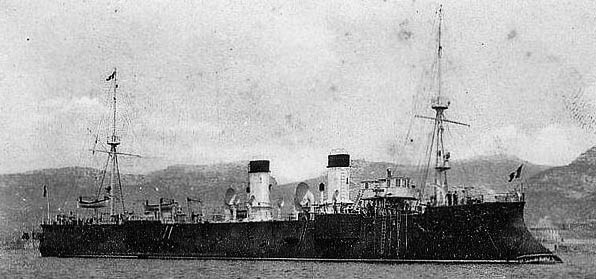
Cruiser Lavoisier – Bougault Coll.
A quite different class from the Forbin and Troude, with a higher freeboard, and short forecastle deck, two large funnels and widely spaced masts. They featured four 5.5 in/45 (140 mm), one masked on the forecastle and the others in sponsons. Two 3.9 in (100 mm) secondary and eight 3-pdr, six 1-pdr guns completed this, and four 21-in TTs above the waterline. Like the previous ships they can carry 120 mines. Only Lavoisier had mixed burning boilers. Galilée and Linois were discarded in 1910, Lavoisier went on to serve during WW2 and until 1920.
Technical specifications
Displacement: 2,285 tons FL
dimensions: 100.63 (98) x 10.62 (10.97) x 5.44 m (Galilée)
Propulsion: 2 shafts VTE, 16 Belleville boilers (Linois 6 cyl. boilers), 6,800 hp, 20.5 knots.
Crew: 250/269
Armament: 4 x 140, 2 of 100, 8 x 47, 6 x 37 mm, 4 x 457 mm TT aw, 120 mines
Descartes class (1894)

The Descartes and Pascal were built at Soc. de la Loire and Toulon yards on similar 3960 tonnes plans. They had plough bows and pronounced tumblehome (dim. 93.3 x 12.9 x 6.5m) fitted with two shafts VTE, 16 Belleville boilers for 8500 ihp and 19.5 knots. They were armed with four 6.4 in guns (164 mm) M1891/93, ten 3.9 in (100 mm), eight 3-pdr, four 1-pdr, nd two 18-in TTs. The main guns were in midship sponsons (plus three more 3.9 in) the rest of the 3.9 in were on the forecastle, poop aft, and one in the bow. The deck guns had 2-in shields.
The CT had 2.8 in walls, the armoured deck was 1.8 in thick on the flat section, 2.4 on the slopes. Over it was a cellular layer and below a debris deck to protect the machinery. Descartes suffered hot ammo rooms problems and lacked ventilation. Both were ballasted for stability. Pascal was stricken in 1911 but Descartes served in WW1 as a patrol ship in the East indies until 1917 and she suffered two ships collisions. Back in Lorient she as disarmed to carry and operated ASW seaplanes and was discarded in 1920.
D’Assas class (1893)
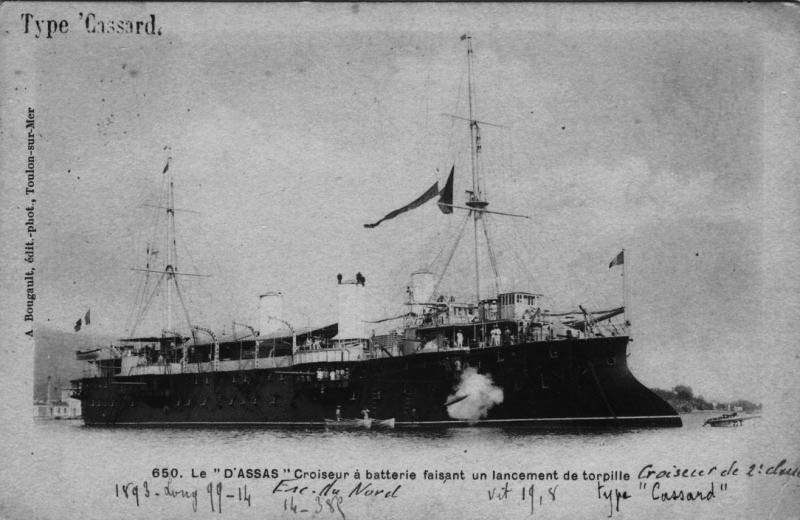
The cruiser D’Assas, Cassard class – Bougault collection (cc)
The D’Assas, Cassard and Du Chayla were very similar to the Friant class, to the exception of their CT protected by 4-in armour, the armoured deck (flat) was 2.8 in and slopes 3.2 in. They were slighlty longer and larger (96.14 x 16.67 x 6.25 m), faster at 20 knots thanks to 10,000 ihp produced by 20 Lagrafel d’Allest boilers mated on two shafts VTE. They carried 600 tons of coal. Armament wise, they carried ten 47 m guns (3-pdr) instead of four and five to nine 1-pdr (37 mm) and larger torpedo tubes of 457 mm (18 in).
D’Assas was discarded in 1914 but the two others served in WW1. Cassard spend her WW1 service in the western Mediterranean ad the red sea but in 1917 she operated with the Indian ocean squadron. From 1922 she was attached to the gunnery school and was discarded in 1923. Du Chayla covered the 1907 Casablanca landing. She was in action in the Atlantic and the read sea from 1916, and until 1918, and afterwards she was off Lebanonand in the blak sea to cover White Russians operations until 1919. However her guns has been requisitions by the army at that time, she was left with two 164 mm, four 75 mm and four 47 mm guns. She was stricken in 1921 but not BU before 1933.
Technical specifications
Displacement: 3,962t – 3,890 tonnes (Cassard and Du Chayla) standard
Dimensions: 96.14 x 13.67 x 6.25 m
Propulsion: 2 shaft VTE, 20 boilers, 10,000 hp, 20 knots.
Armour: From 85 mm armored deck slopes to 125 mm CT, 4 mm shields.
Crew: 392
Armament: 6 x 163, 4 x 100, 10 x 47, 5-9 x 37 mm, 2 x 457 mm TT aw.
Protected Cruiser D’Entrecasteaux (1893)

Built at La Seyne in Toulon between 1894 and 1899, this protected cruiser, which cost 16,700,000 gold francs at the time, was well protected with copper-lined wooden plates and a pear section. Her poorly arranged interior fittings and ventilation made her the “hotter” French cruiser in bunkers and machines. It was decided to quickly add a ventilation system.
D’Entrecasteaux led a career without notable incident first in the Channel, then in the Mediterranean. She survived the war and was stricken from the lists in 1922. She was then rented to Belgium temporarily, but soon the navy separated from it, having no means to exploit her. She was sold in 1927 to Poland at Scrap price, renamed Baltyk, used as a submarine depot ship (photo) and still existed, docked in Gdynia in 1942. The Germans scrapped her.
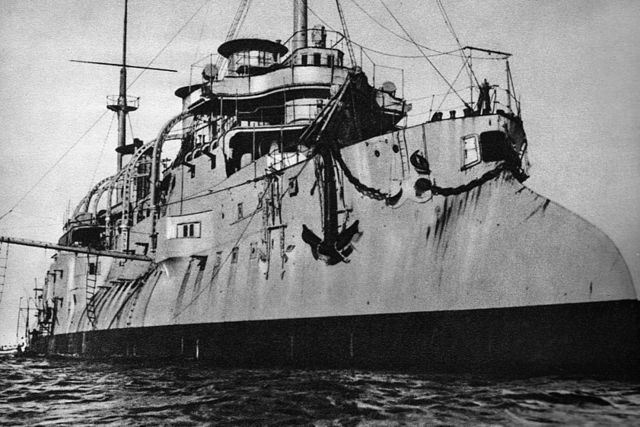
The Polish cruiser ORP Baltyk during the interwar.
Technical specifications
Displacement: 7,995t FL
Dimensions: 117 x 18 x 7.5 m
Propulsion: 2 shaft VTE, 5 boilers, 14,500 hp, 19.2 knots.
Armour: from 250 mm turrets to 20 mm decks
Crew: 559
Armament: 2 x 192, 12 x 140, 12 x 47, 6 x 37 mm, 2 x 457 mm TT sub.
Protet Class (1896)
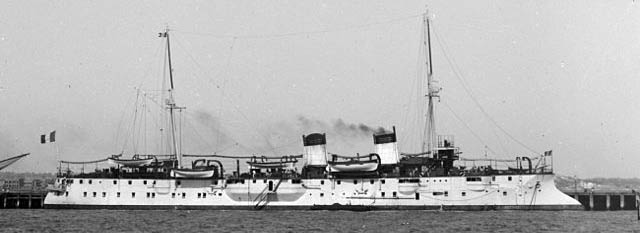
Protet -library of Congress
Built at FC de la Mediterranée (Catinat) and Soc. de la Gironde (Protet) in 1894/96 and launched in 1896/98, completed in 1898/99, these cruisers were near-repeats of the Descartes class (derived from the Friant design). They were 4,000 tonnes protected cruisers with their main guns in sponsons, secondary 100 mm (3.9) ones fore and aft in pairs under 2-in masks, and the rest in sponsons. Two funnels, two light masts far apart, tumblehome and recesses for the sponsons. They could also carry 50 mines, stowed in the steering engine compartment and the rail was going through the captain’s cabin. They were dropped through a single stern port. Stability on these ships was doubtful and Protet was heavily ballasted. None saw action suring the war, they were discarded in 1910 and 1911.
Protected Cruiser Guichen (1897)

The Guichen was started in 1895 at the Loire NyD and completed in 1899. She was a commerce raider, intended to make war on trade. She was fast enough and her autonomy was high. Her boilers were designed to burn fuel oil with coal, taking up less space on board. The Guichen first operated in the Channel in 1914, and then she was sent to the Atlantic Squadron, operating in the Bay of Biscay. Next she was sent to Morocco, and the Eastern Mediterranean. She helped evacuating thousands of Armenians from the 1915 Turkish genocide. From 1917 she operated in the Aegean Sea, and by 1919 served with Black Sea Sqn, assisting white Russians in Crimea. She was removed from the lists in 1922 and later scrapped.
Technical specifications
Displacement: 8150t. PC;
Dimensions 133 x 17 x 7.5 m
Propulsion 3 propellers, 2 VTE machines, 36 D’Allest boilers, 25,000 hp. and 231.5 knots max.
shielding from 157 to 56 mm-; Crew 604
Armament 2 guns of 162, 8 of 140, 10 of 47, 5 of 37 mm, and 2 TLT flanks SM 457mm.
Protected Cruiser Chateaurenault (1898)

Author’s illustration of the Chateaurenault, showing its obvious liner style.
This light cruiser built in La Seyne, started in 1896 and completed in 1902, had characteristics borrowed on the Guichen on protection and armament, but was treated differently in shape, displaying the deceiving profile of liner. This had the advantage of luring a potential predator, and could pay off later in submersible warfare as a Q-ship. She will prove faster than the Guichen at lower power. Based in the Mediterranean, after operating with the 2nd squadron in the Channel, she participated in the hunt for the German raider Möwe. Later she acted as a troops carrier. She did not, however, fooled UC38, that torpedoed her on December 14, 1917, off Corfu. Slowly sinking, this allowed almost all her crew to evacuate, together with troops, in total 1,162 men, without any human losses.
Technical specifications
Displacement: 7900t. 8200 t. FL
Dimensions: 135 x 17 x 7.4 m
Propulsion: 3 shafts, 2 VTE steam engines, 14 Normand boilers, 23,000 hp, 24 knots.
Armor: Turrets 120 mm, decks 20-25 mm
Crew: 604
Armament: 2 x 162, 6 x 140, 10 x 47, 5 x 37 mm.
D’Estrées class (1899)
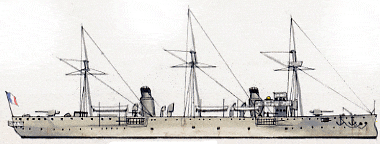
Author’s rendition of the D’Estrées in 1914.
The D’Estrées in 1914 was the sole protected cruiser of the class bearing her name, but also comprising her sister-ship Infernet (1899). The latter was removed from the lists in 1910. These ships were designed for colonial service in the far East (Indochina). D’Estrées was one of the last French protected cruisers in 1899. Small, medium-range, lightly armored ships with an internal turtleback armored deck. Infernet was badly damaged and removed from service in 1910. D’Estrées sailed for the mediterrannean, and operated until 1915, then the Red Sea until 1918. After a short overhaul, she went back to the Far East until her final withdrawal in 1922.
Technical specifications
Displacement: 2428t PC
Dimensions 95 x 12 x 5.4m
Propulsion: 2 turbines, 8 Normand boilers, 8500 hp. 20.5 knots.
Armour: Armoured deck 43 mm, bridge, shields and casemates
Crew: 235
Armament: 2 x 140, 4 x 100, 8 x 47, 2 x 12.7 mm HMGs.
French Armoured Cruisers
Dupuy de Lôme (1890)
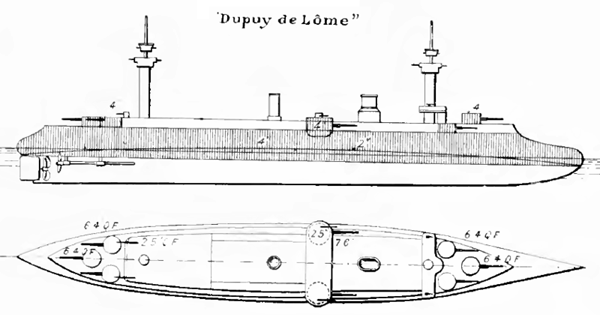
Brassey’s basic blueprint in 1902
This cruiser was marked as a landmark in naval design, and considered by some authors to be the world’s first armoured cruiser. She was however intended to attack enemy merchant ships and destroy any cruiser opposition. However her development was plagued by boilers and machinery problem. She was eventually commissioned in May 1895. Her career was spent without notable incident, mainly in the Mediterranean.
The French armoured cruiser should have been sold in Peru in 1912, but the sale failed and she was re-acquired by the French Navy, after her 1910 decommission. Until 1914 she has been left almost without maintenance, and after some overhaul she was used as a port guardian, carrying out patrols. With new machinery installed in 1905 she had three funnels and her military masts has been replaced by lighter masts. A controversial photo shows what’s looks like a camouflage in 1916, but it’s likely to be the shadow of overhanging boats. She was eventually resold to the Belgians in 1920 and was used as a freighter under the name of… Peruvian after a radical new overhaul.
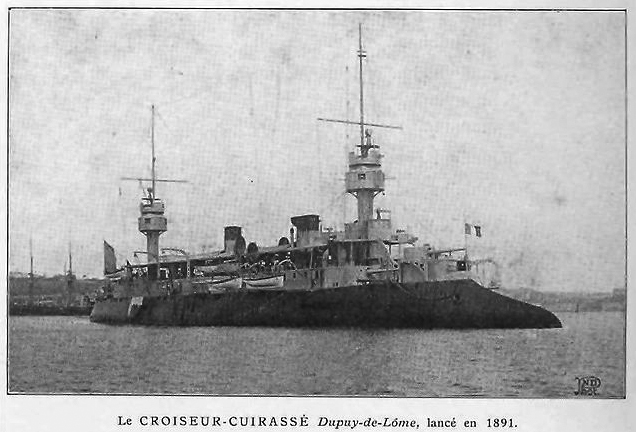
Postcard of the ship – Bougault coll.
Technical specifications
Displacement: 6680t. FL
Dimensions: 111 x 15.70 x 7.5 m
Propulsion: 2 shafts VTE, 20 Normand boilers, 16,000 hp. and 20 knots
Armor: from 102 to 130 mm
Crew: 520
Armament: 2 x 193, 6 x 162, 4 x 65, 8 x 47, 8 x 37 mm, 2 x 457 mm TTs.
Amiral Charner class (1892)
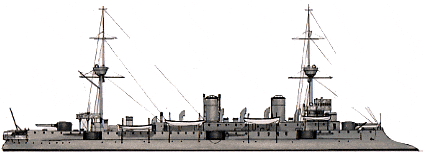
Author’s rendition of the Admiral Charner in WW1
The previous cruiser was considered a prototype for this class. It consisted of four ships originally: Admiral Charner, Bruix, Chanzy, and Latouche-Tréville, launched in 1892-94 and commissioned in 1894-96. Admiral Charner’s keel was laid down in 1889 at Rochefort. These four modest cruisers had an excellent, almost complete, thick protection at many key points. They traded this however for speed, not being able to reach their designed 19 knots mark.
Despite careful maintenance, their machinery was worn out in 1914 and top speed was usually 15-16 knots. Thick military masts were fitted as designed, but they were replaced to improve their stability by light masts. Light armament, which comprised six 1-pdr (37 mm) and four 2 pdr (47 mm) was deleted ast this occasion. Chanzy was wrecked on May 30, 1907 off China. The other three were active during the Great War, Admiral Charner was torpedoed by U21, sinking in 4 minutes on February 8, 1916 in the Mediterranean. The other two were disarmed in 1920 and 1926.
Technical specifications
Displacement: 4681 tonnes, 4737 tonnes Fully loaded
Dimensions: 106 x 13.97 x 6 m
Propulsion: 2 shafts 2 VTE, 16 Belleville boilers, 8000 hp., 19 knots.
Armour: 92 mm belt, 110 mm turrets
Crew: 393
Armament: 2 x 193, 6 x 140, 4 x 65 mm, 4 x 457 mm TTs sub.
Armoured cruiser Pothuau (1895)

Cruiser Pothuau (Author’s illustration)
The Pothuau was a single cruiser, relatively small and sometimes classed as a protected cruiser as her belt protection was thin. She had inded a complete belt from 4 feets 11 inches belowe the waterline up to 8 feets 2 in above it, and inside was a curved armor deck with 3.3 in thick slopes, 1.7 in horizontal surface, and thin splinter deck over the machinery. The 193 mm guns were placed in single turrets fore and aft, and the ten 140 mm guns were in casemated barbette alongside the hull with recesses for forward and rear firing, plus two in side sponsons in the center. Three funnels, two light masts wide apart, a plough bow and tumblehome made this single ship a typical French cruiser of the time, which participated actively in WW1 and was discarded in 1929.
Technical specifications
Displacement: 5,374 tonnes, 6,200 tonnes Fully loaded
Dimensions: 110 x 15.30 x 6.5 m
Propulsion: 2 shafts VTE, 18 Belleville boilers, 10,000 hp., 19 knots.
Armour: 58 mm belt, Deck 83 mm, turrets 180 mm, CT 230 mm.
Crew: 459
Armament: 2 x 193, 10 x 140, 10 x 47 mm, 8 x 37 mm, 4 x 457 mm TTs aw.
Armoured cruiser Jeanne d’Arc (1899)


“La Jeanne” in 1900 as built and in Grey livery in wartime.
First large French armoured cruiser, she was also the first training ship to bear this famous name. During the Great War, she was used in a round with the Jauréguiberry, participating in the capture of Ruad island in 1915, and sailed to the Mediterranean to cover the Gallipoli landings. She escorted convoys between France and the USA in 1917-18. In 1919 she returned to her role as a training ship, until 1928 when she was replaced by a new ship of the same name. Photo
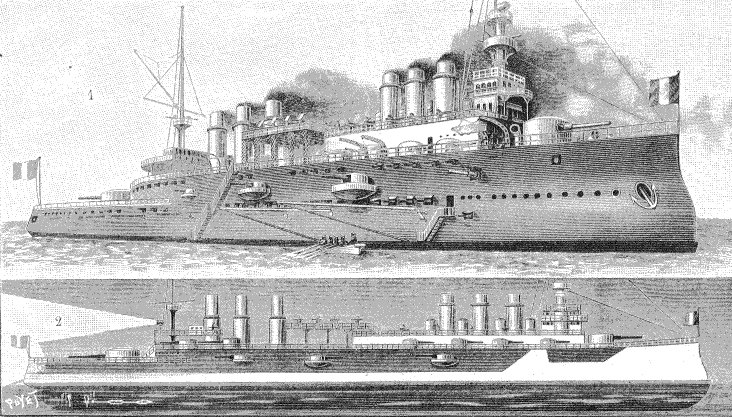
Jeanne d’Arc, engraving by Louis Poyet.
Technical specifications
Displacement: 11 100t. FL
Dimensions: 145.4 x 19.4 x 8.10 m
Propulsion: 2 shafts VTE 36 DuTemple boilers 33,000 hp. 21.8 knots.
Armour: 180 to 45 mm
Crew: 651
Armament: 2 x 193, 14 x 140, 16 x 47, 6 x 37 mm, 2 x 457 mm TTs.
Gueydon class cruisers (1900)

Author’s illustration of the Gueydon, in wartime livery
The Gueydon class included the Gueydon, Dupetit-Thouars and Montcalm, started in 1898-99 and completed in 1902-05. They were smaller than Joan of Arc, equipped with more modern weaponry, and faster. They served as a model for all French cruisers-cruisers to come. Their career during the Great War and after was quite rich: The Gueydon was employed on escort missions in the Atlantic, but was also part of the Indochina squadron, and sent to the Arctic and Baltic to support the whites in 1919 -1920. In 1923 he was rebuilt, then served in France before being assigned to school in 1928, first of the gunners and then cadets.
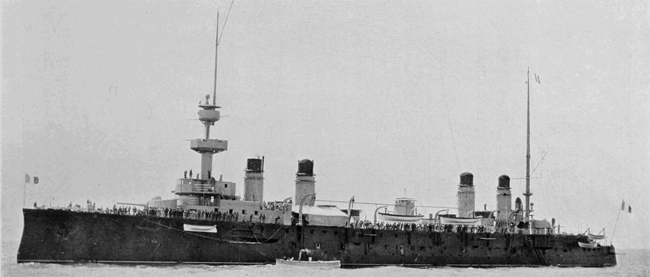
Montcalm, from an unknown magazine, 1902 (cc)
In 1935 he was disarmed, anchored in Lorient and used as a barracks. In 1942 the Germans demolished it. Montcalm joined the Australian squadron in 1914 and participated in the capture of Samoa and other German possessions from the Pacific. After a long overhaul in 1916, he was sent the 4th squadron of Eastern Indian cruisers then escorted convoys in the Atlantic.
It was erased from the lists in 1933 and used as floating pontoon in Brest under the name of Trémintin. The Germans had it demolished in 1943. Dupetit-Thouars did all its service in the Channel and in the Atlantic. He was torpedoed on August 7, 1918 off Brest, returning from the escort of 28 American freighters from New York. The American destroyers saved practically all his crew.
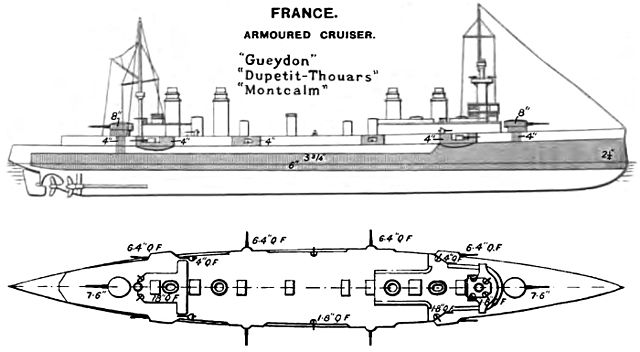
Brassey’s diagram of the Gueydon
Technical specifications
Displacement: 10,200 t. FL
Dimensions: 139.8 x 20.2 x 7.7 m
Propulsion: 3 shafts, 2 VTE engines, 28 Niclausse boilers, 21,800 hp. 21.5 knots.
Armor: Belt 152, turrets 172, blockhouse 81, turrets 100 mm-
Crew: 615
Armament: 2 x 193, 8 x 162, 6 x 100, 18 x 47 mm and 2 x 457mm TT sub.
Dupleix class armoured cruisers (1900)

Author’s illustration of the Dupleix
The Dupleix class also included the Desaix and Kléber. They were started in 1897-98 and completed in 1903-04, 5-6 years of construction. As a result, their design was already obsolete at the time of the Russo-Japanese War. Although well protected, these cruisers were poorly armed and were a step back from Gueydon, including speed.
-Desaix patrolled the Channel before being posted in defense of the Suez Canal with Montcalm. She was partially disarmed in 1917 and joined the cruiser Glory in the Far East, remaining there until 1922.
-Dupleix was present in Indochina since 1910 and participated in the Von Spee squadron’s hunt in 1914, capturing German vessels. She returned to the eastern Mediterranean, shelling Bodrum. She was then posted to the North African squadron until 1927.
-Kleber served in the Channel and on the Atlantic with the Joan of Arc in 1914. He was then sent to cover the Gallipoli landing, where she was seriously affected. Her commander beached her to avoid sinking. She was refloated, towed and repaired in Toulon. She carried out shelling missions in the Aegean Sea and then returned in drydock following a collision with an English steamer. She was detached to Dakar in 1916 after a short overhaul in Bordeaux. Back to Brest in 1917, she hit a mine laid by UC61 on June 27, 1917 and sank slowly with 18 crewmen, the rest survived.
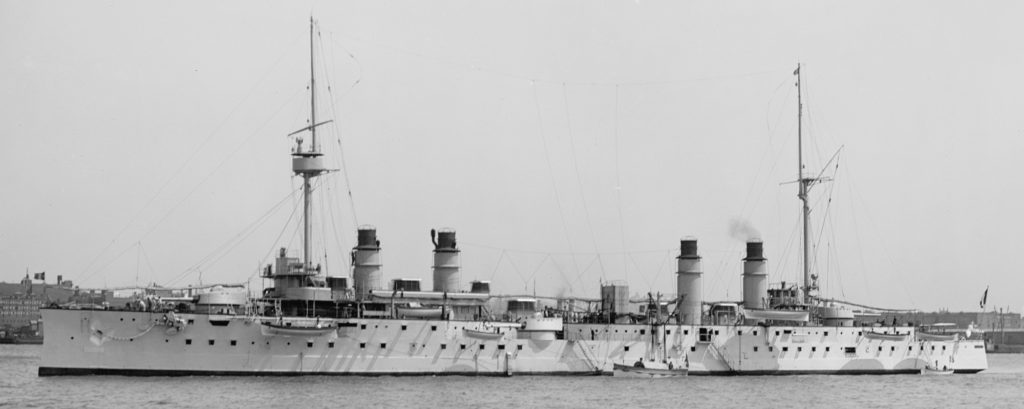
Kléber in the U.S. before the First World War. Library of Congress (cc)
Technical specifications
Displacement: 5595t. FL
Dimensions: 137 x 15 x 6.30 m
Propulsion: 3 shafts VTE, 24 boilers Du Temple 17,400 hp, 22.9 knots.
Armour: 45 mm
Crew: 463
Armament: 8 x 162, 10 x 47 and 6 x 37mm, 2 x 457 mm TTs sub.
Gloire class armoured cruisers (1900)

Armoured cruiser Gloire – Author’s illustration
These five ships derived from Gueydon which they took again many characteristics. They were five in number, started in 1899-1900, launched between 1900 and 1902 and completed in 1903-04. The class included Glory, Conde, Admiral Aube, Marseillaise and Sully. Their armament remained unchanged from the Gueydon, but in a different way, they were noticeably larger, but their speed remained almost unchanged. They walked mainly with coal, but had a reserve of 80 tons of fuel oil.
Outside the Sully, which struck a reef in Indochina on September 30, 1905, and sank body and property, the three others served in the Atlantic and Admiral Aube in the Mediterranean. They escorted the convoys without making losses despite their poor underwater protection, like the other French cruisers. Glory suffered a collision with a US liner and made a stopover in New York for repairs in 1918.
The Condé was disarmed in 1933 only and served as a barracks-ship until 1940. It was used as a storage ship for U- Booted by the Germans in Lorient, then served as a target for planes until 1945 before being demolished. The Marseillaise became a training ship for gunners in 1925 and was demolished in 1929.
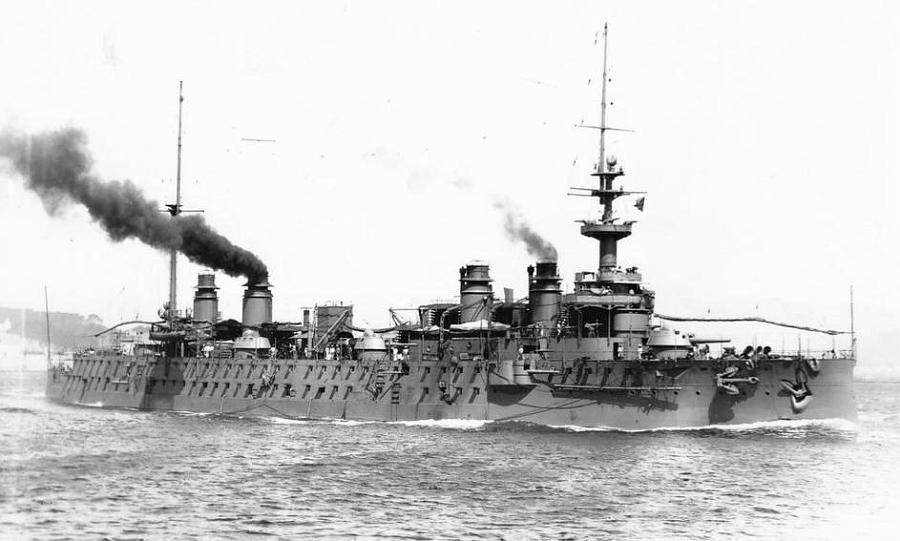
French cruiser Gloire steaming up, The University of Washington Libraries (cc)
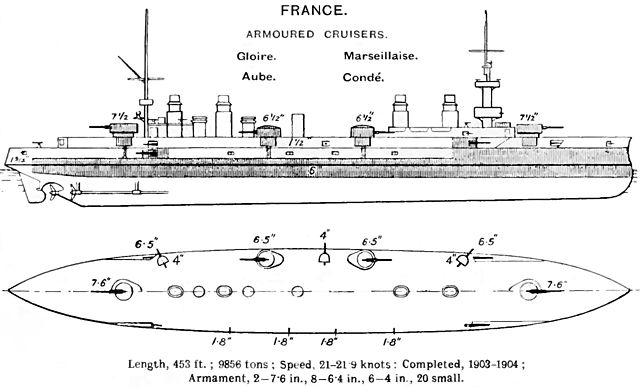
The cruiser Gloire, Brassey’s diagram 1912
Technical specifications
Displacement: 10 200 t. FL
Dimensions: 139.8 x 20.2 x 7.7 m
Propulsion: 3 shafts, 2 VTE, 28 Niclausse boilers, 21,800 hp. 21.5 knots max.
Armor: belt 152, turrets 172, CT 81, turrets 100 mm
Crew: 615
Armament: 2 x 193, 8 x 162, 6 x 100, 18 x 47 mm, 2 x 457mm sub TTs.
Léon Gambetta class armoured cruisers (1902)
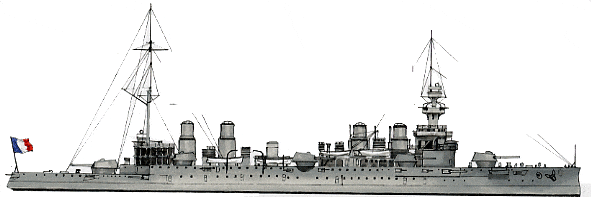
Author’s illustration of the Gambetta class
This class included Léon Gambetta (1901), Jules Ferry (1903), and Victor Hugo (1904). They were started in 1901-03 and completed in 1905-07. More so than the Glories, they were more powerfully armed. Their 47 mm high-speed parts were a newer, more efficient model, but they were freed from a number of superfluous carriages during the war, four being mounted on AA carriages.
Gambetta struck a reef during its tests and was put into service. His protection under the waterline was also mediocre, as evidenced by its tragic end. During the Great War, the three buildings were in the western Mediterranean and also served in the Adriatic. On April 27, 1915 the Austrian U5 sent two torpedoes in the flank of the Gambetta which capsized and sank in 10 minutes, taking with him almost all his crew. The officers accompanied in death Rear-Admiral Senes.
Victor Hugo accompanied the Jean Bart to Malta, after the latter concealed a torpedo, and evacuated with Michelet the Serbian troops from Corfu to Bizerte. They were put in reserve in 1923 and sent to the Far East in 1928, before being definitively erased from lists in 1930. The Ferry had a career without notable incidents and was retired in 1927.

Brassey’s diagram of the Gambetta
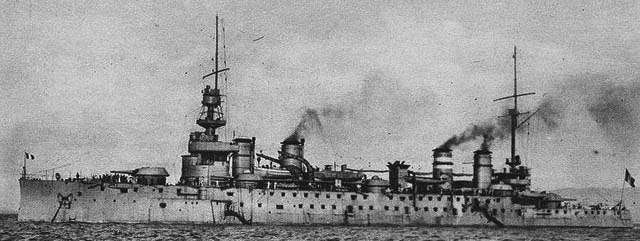
Léon Gambetta, from War of the Nations, New York Times Co., New York, 1919.
Technical specifications
Displacement: 13,847 t. FL
Dimensions: 159 x 21.5 x 8.4 m
Propulsion: 3 shafts VTE, 40 Belleville boilers, 36,000 hp. 23 knots
Armour: 203 mm, 152 mm
Crew: 892
Armament: 14 x 193mm, 20 x 65, 2 x 457 mm TT sub.
Armoured cruiser Jules Michelet (1905)

Author’s Illustration of the Michelet
This ship was practically an improved copy of the Gambetta she was following. She differed only in details, including her artillery arrangement. She kept the same speed despite greater power, and this due to a slightly higher displacement. She served in the Mediterranean during the war and was used as a target ship until 1937.
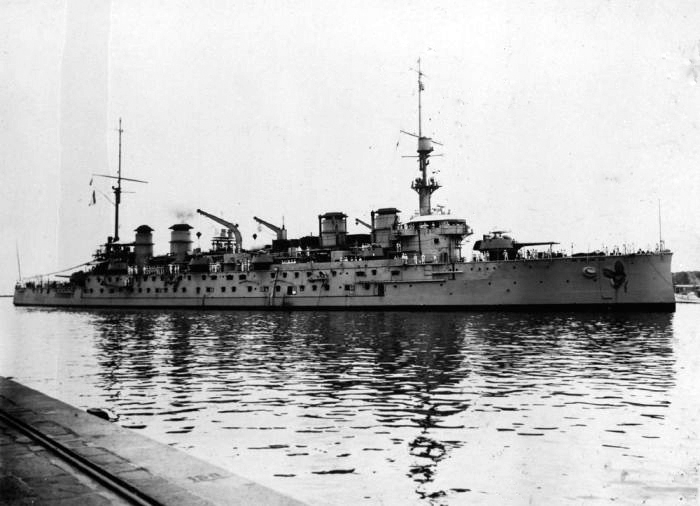
Jules Michelet as seen by the Dutch Gouverneur-General at Tadjong Priok (cc)
Technical specifications
Displacement: 13 105t. FL
Dimensions: 146.5 x 21.41 x 8.41 m
Propulsion: 2 shafts VTE, 28 boilers Du temple, 30,000 hp. 22.5 knots.
Armour: from 203 to 45 mm; Crew 770
Armament: 4 x 193, 12 x 162, 24 x 47, 2 x 457 mm TT sub.
Armoured cruiser Ernest Renan (1906)

Author’s illustration of Ernest Renan
One of the last French cruiser-cruisers, the Renan, designed by Emile Bertin, came directly from Gambetta-class ships, such as the Michelet (1905). But it differed in the arrangement of boilers, giving it its elongated silhouette and six very characteristic chimneys, for a higher displacement. It was also significantly faster, able even according to its designer to spin 25 knots with the boilers originally planned giving it 42,000 hp.
She had a secondary armament against torpedo boats , 16 guns moref 65 mm guns, receiving during the war several AA guns. She served until 1918 in the Mediterranean, then as a training ship, even receiving a floatplane in 1927, and losing his mast before. It was removed from the lists only in 1931.
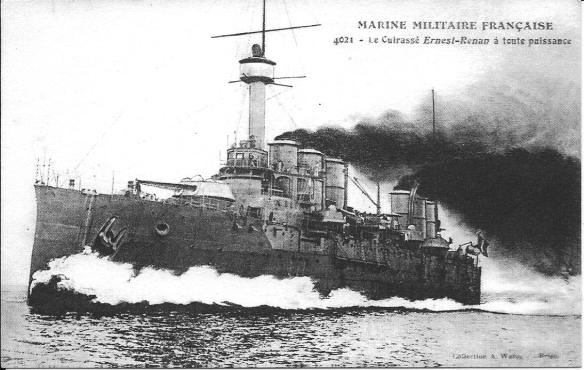
Renan at ful speed – Journal of the American Society of Naval Engineers. Washington, DC: R. Beresford.
Technical specifications
Displacement: 13 500t. FL
Dimensions: 149 x 21.34 x 8.36 m
Propulsion: 2 shafts VTE, 42 Niclausse boilers, 36,000 hp. 23 knots.
Armour: from 203 to 55 mm
Crew: 824
Armament: 4 x 193, 12 x 162, 16 x 65, 8 x 47, 2 x 37 mm, 2 x 457 mm TTs sub.
Edgar Quinet class Armoured cruisers (1906)

Author’s illustration of Quinet
The last French armoured cruisers, and by far the most imposing, the two Quinet (the second being the Waldeck-Rousseau) were both a synthesis of the experience gained and an additional milestone in the genre.
Laid down in 1905 and 1906 they were launched in 1907-08 they were completed in 1911. They displaced 14,000 tons and were 160 meters long, and were part of the largest French warships in 1914. They were inspired by the Ernest Renan (1906), but larger and better armed, including a uniform artillery distribution, of a “monocaliber” type, with the removal of the 162 mm intermediary turrets for a complete battery of fourteen 193 mm guns completed by light QF 65 mm guns. This made these ships the first “monocaliber” in service with France, although their caliber cannot compete with true dreadnoughts.
The heavy guns were splitted into two twin turrets, six single turrets, and four in barbettes. The 65 mm guns were placed in eight barbettes and the remainder were located on the battery bridge. These cruisers reached 23 knots, but they ultimately ate a budget that could have been affected on the first French battle cruisers (never started).
Their career was very active though. With Renan and Michelet, they formed the 1st “light” division of the Mediterranean. They participated in August 1914 in the pursuit of the German squadron (admiral Souchon), and patrolled in the Strait of Otranto.
After the war, Quinet carried out a rescue mission for the population of Smyrna, ecavuating 1200 civilians in 1922. In 1925-27, she underwent a complete overhaul, and became a training ship with a new armament, new appearance, and seaplanes under hangar. She struck a reef at Cape Blanc off Algeria and sank in 1930. Waldeck Rousseau served in the Adriatic and survived two torpedos from an Austrian U-Boote. She also served in the Ionian and Aegean seas and later the Black Sea, in support General Wrangel’s “White Russians”. She was left unmodified, placed in reserve, disarmed in 1932 and scrapped afterwards.
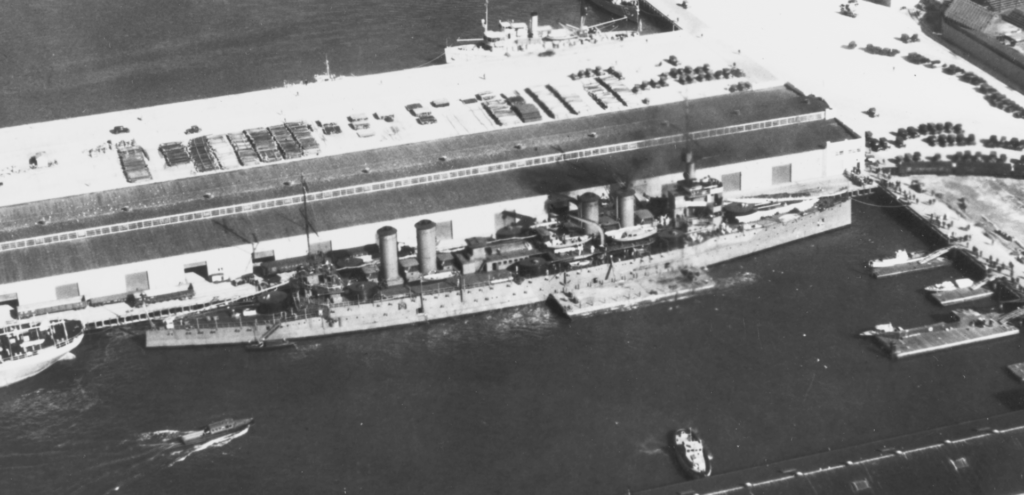
The Edgar Quinet in December 1928, in San Diego, Cal. See also: http://www.archeosousmarine.net/quinet.php
Technical specifications
Displacement: 13,847 t. FL
Dimensions: 159 x 21.5 x 8.4 m
Propulsion: 3 shafts VTE, 40 Belleville boilers, 36,000 hp. 23 knots
Armour: 203 down to 152 mm
Crew: 892
Armament: 14 x 193 mm, 20 x 65, 2 x 457 mm TT sub.
Read More/Src
Roger Chesneau, Eugène M. Koleśnik, Conway’s All the World’s Fighting Ships (1860-1905)
Robert Gardiner et Randal Gray, Conway’s All the World’s Fighting Ships (1906-1921)
Eric Gille, Cent ans de cuirassés français, Nantes, Marines édition
http://le.fantasque.free.fr/php3/gun.php3?page_size=M#mn_spl_194_40_87
http://www.navweaps.com/Weapons/WNFR_76-50_m1902.php
Dictionnaire des bâtiments de la flotte de guerre française de Colbert à nos jours, Tome II, 1870–2006
https://en.wikipedia.org/wiki/List_of_cruisers_of_France
http://fr.naval-encyclopedia.com/1ere-guerre-mondiale/marine-francaise.php#crois

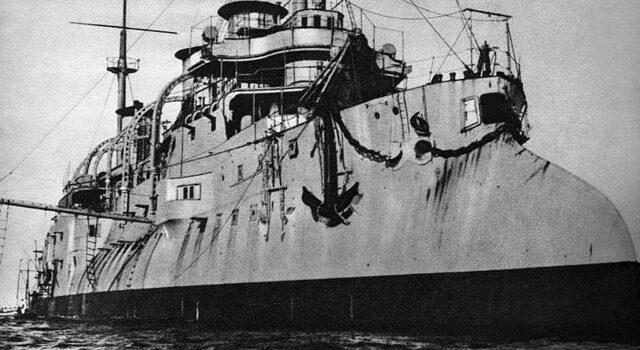
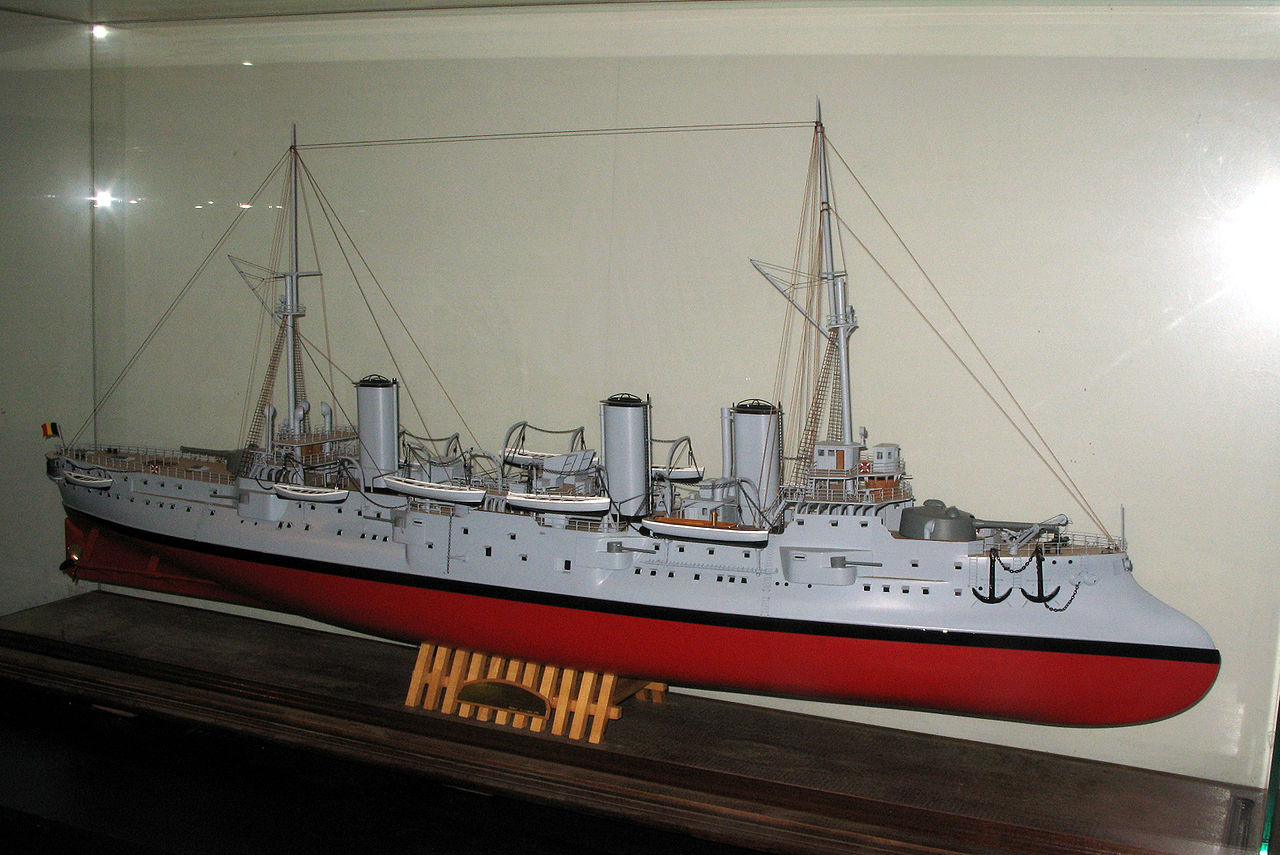
 Latest Facebook Entry -
Latest Facebook Entry -  X(Tweeter) Naval Encyclopedia's deck archive
X(Tweeter) Naval Encyclopedia's deck archive Instagram (@navalencyc)
Instagram (@navalencyc)





 French Navy
French Navy Royal Navy
Royal Navy Russian Navy
Russian Navy Armada Espanola
Armada Espanola Austrian Navy
Austrian Navy K.u.K. Kriegsmarine
K.u.K. Kriegsmarine Dansk Marine
Dansk Marine Nautiko Hellenon
Nautiko Hellenon Koninklije Marine 1870
Koninklije Marine 1870 Marinha do Brasil
Marinha do Brasil Osmanlı Donanması
Osmanlı Donanması Marina Do Peru
Marina Do Peru Marinha do Portugal
Marinha do Portugal Regia Marina 1870
Regia Marina 1870 Nihhon Kaigun 1870
Nihhon Kaigun 1870 Preußische Marine 1870
Preußische Marine 1870 Russkiy Flot 1870
Russkiy Flot 1870 Svenska marinen
Svenska marinen Søværnet
Søværnet Union Navy
Union Navy Confederate Navy
Confederate Navy Armada de Argentina
Armada de Argentina Imperial Chinese Navy
Imperial Chinese Navy Marinha do Portugal
Marinha do Portugal Mexico
Mexico Kaiserliche Marine
Kaiserliche Marine 1898 US Navy
1898 US Navy Sovietskiy Flot
Sovietskiy Flot Royal Canadian Navy
Royal Canadian Navy Royal Australian Navy
Royal Australian Navy RNZN Fleet
RNZN Fleet Chinese Navy 1937
Chinese Navy 1937 Kriegsmarine
Kriegsmarine Chilean Navy
Chilean Navy Danish Navy
Danish Navy Finnish Navy
Finnish Navy Hellenic Navy
Hellenic Navy Polish Navy
Polish Navy Romanian Navy
Romanian Navy Turkish Navy
Turkish Navy Royal Yugoslav Navy
Royal Yugoslav Navy Royal Thai Navy
Royal Thai Navy Minor Navies
Minor Navies Albania
Albania Austria
Austria Belgium
Belgium Columbia
Columbia Costa Rica
Costa Rica Cuba
Cuba Czechoslovakia
Czechoslovakia Dominican Republic
Dominican Republic Haiti
Haiti Hungary
Hungary Honduras
Honduras Estonia
Estonia Iceland
Iceland Eire
Eire Equador
Equador Iran
Iran Iraq
Iraq Latvia
Latvia Liberia
Liberia Lithuania
Lithuania Mandchukuo
Mandchukuo Morocco
Morocco Nicaragua
Nicaragua Persia
Persia San Salvador
San Salvador Sarawak
Sarawak Uruguay
Uruguay Venezuela
Venezuela Zanzibar
Zanzibar Warsaw Pact Navies
Warsaw Pact Navies Bulgaria
Bulgaria Hungary
Hungary

 Bundesmarine
Bundesmarine Dutch Navy
Dutch Navy Hellenic Navy
Hellenic Navy Marina Militare
Marina Militare Yugoslav Navy
Yugoslav Navy Chinese Navy
Chinese Navy Indian Navy
Indian Navy Indonesian Navy
Indonesian Navy JMSDF
JMSDF North Korean Navy
North Korean Navy Pakistani Navy
Pakistani Navy Philippines Navy
Philippines Navy ROKN
ROKN Rep. of Singapore Navy
Rep. of Singapore Navy Taiwanese Navy
Taiwanese Navy IDF Navy
IDF Navy Saudi Navy
Saudi Navy Royal New Zealand Navy
Royal New Zealand Navy Egyptian Navy
Egyptian Navy South African Navy
South African Navy






























 Ukrainian Navy
Ukrainian Navy dbodesign
dbodesign